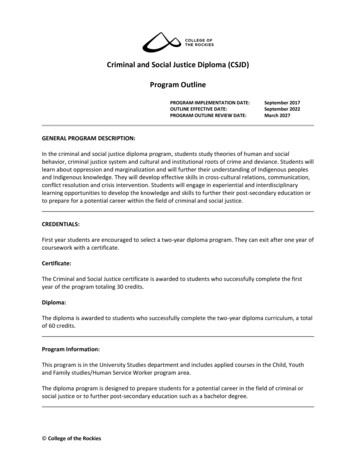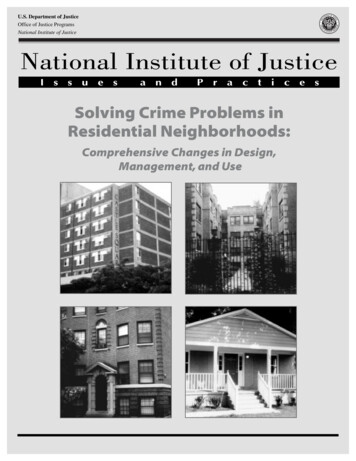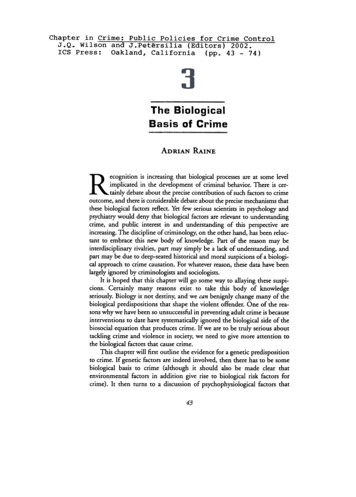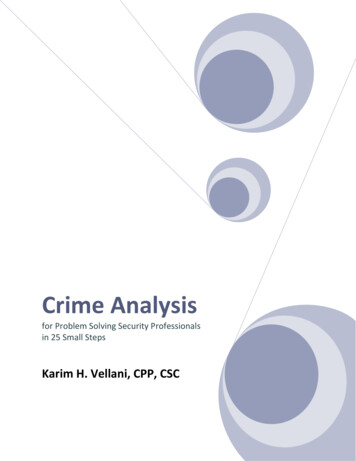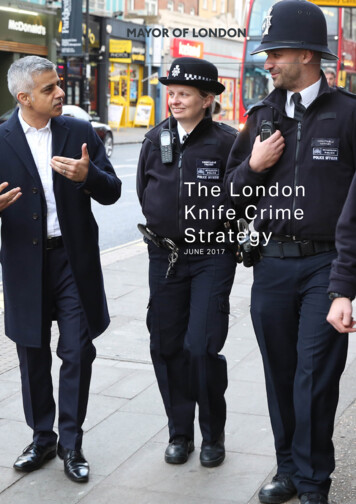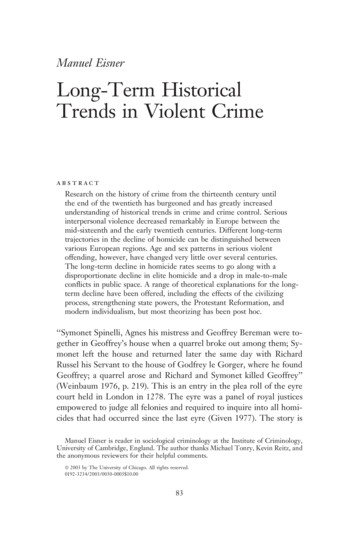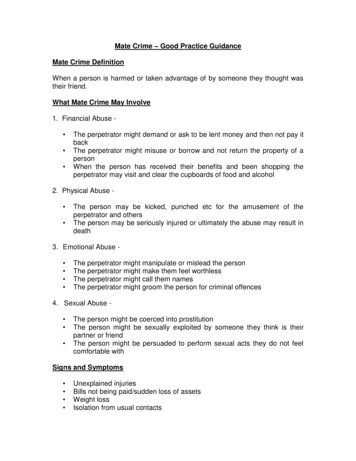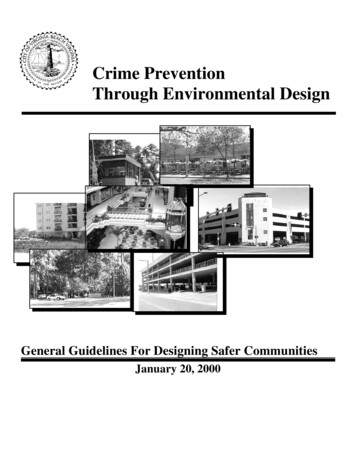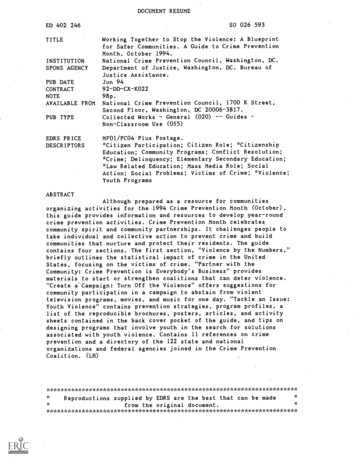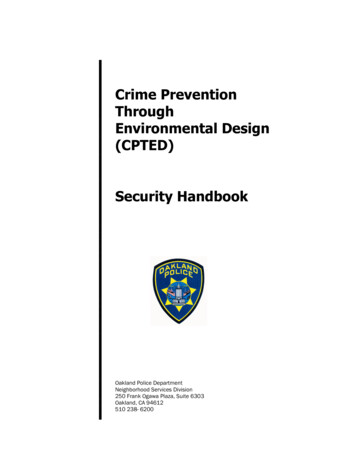
Transcription
Crime PreventionThroughEnvironmental Design(CPTED)Security HandbookOakland Police DepartmentNeighborhood Services Division250 Frank Ogawa Plaza, Suite 6303Oakland, CA 94612510 238- 6200
Table of ContentsCPTED: What can it do for you? . 1Why does it work?. 2How does it work? . 3Natural Surveillance. 3Territorial Reinforcement . 3Access Control. 3Maintenance. 4How do I do it? . 5What am I trying to accomplish in this space? . 5Using the surveys . 6Residential Survey . 7Commercial Survey . 9CPTED Strategy Reference. 11Natural Surveillance. 11Territorial Reinforcement . 11Access Control. 12Maintenance. 12Lighting. 13Goals of lighting. 13Types of outdoor lighting . 13Color rendering. 14Purposes of security lighting. 15Proper use of various lights. 15Lighting terminology . 15Light and lamp comparison . 15
CPTED: What can it do for you?Physical environment greatly influences crime, fear of crime, and quality of life. Therelationship between physical environment and crime has become more evident inrecent decades as people make increasing use of locks, bars on windows, cameras,and alarm systems. Although these tools can have a legitimate role to play in crimeprevention, they are not the complete answer. For a crime prevention strategy to beeffective, it must be comprehensive.The solution is an approach called “CPTED,” or “Crime Prevention ThroughEnvironmental Design.” As defined by the National Crime Prevention Institute,CPTED is: a crime prevention philosophybased on the theory that the properdesign and effective use of the builtenvironment can lead to areduction in the fear of crime aswell as an improvement in thequality of life.CPTED works by decreasing a criminal’s ability to commit crime and increasingthe chances that the crime will be seen by legitimate citizens. CPTED goes beyondtraditional security methods by naturally integrating security measures into thecommunity. The goal of ALL CPTED applications is to:Increase the Quality of LifeDecrease Fear of CrimeDecrease CrimeBy following the strategies presented in this handbook, homeowners, apartmentresidents, and business owners can achieve each of these goals. On pages 2-5, youwill find additional information about how CPTED works. On pages 6-10, there arespecial CPTED surveys meant specifically for single family home residents,apartment residents, and business managers or owners. The pages on lightingdescribe the various lighting types available and their efficiency.CPTED Security Handbook1
Why does it work?CPTED is effective because of a concept called “defensible space.” This conceptsuggests all space in the human environment is defendable: someone may takeresponsibility for the space and take action to defend it from non-legitimate,criminal, or unintended use. Alternately, space can be undefended. When there is noidentifiable person who is responsible for the space, it is left exposed to criminal use.Crime is more likely to happen at a location if it is not defended, and crime is lesslikely to occur if an area is defended. The person defending an area may be theowner of the property, but they may also be a tenant, a property manager, or anemployee.In order to defend a location, it must be clearly identified and delineated, it mustbe modified to prevent access of unauthorized persons, and it must provide goodvisibility for witnesses in the event of a crime. The purpose of CPTED is to allowthese things to be accomplished in ways that do not interfere with non-criminalactivities. Does this sound difficult? Surprisingly, it is not. Defending a location maybe as simple as building a small fence, installing an address marker, or cutting backweeds.CPTED works because criminals avoid doing crime in the presence of legitimatecitizens. Property that has been properly defended suggests to a criminal that alegitimate citizen may be near to witness the crime and call the police. Property thatis not defended tells the criminal that no one is watchingand they are safe to commit their crime. Like the table atUnsafeSafethe right shows, undefended places that are safe forCitizenCriminalcriminals to commit their crimes are unsafe places forCriminalCitizenlegitimate citizens. Alternately, places that aredefended and safe for legitimate citizens cause thecriminal to fear detection and arrest for their crimes. TheCPTED goal is to make every location unsafe for criminal activity while also makingthe same locations safe and inviting for legitimate citizens.CPTED Security Handbook2
How does it work?CPTED is applied in the community through one of four overlapping strategies.Each strategy employs a slightly different method of sending a clear message tocriminals that a responsible person is nearby and their activity is not welcome. Thissection of this handbook will tell you about each of the strategies, and you will learnhow to begin applying them in the next section.Natural SurveillanceNatural Surveillance is the placement of physical features,activities, and people in ways that maximize the ability to seewhat is occurring in a given space. This is often thought of as theonly strategy of CPTED, but it is only a quarter of successfulCPTED effort. An example of natural surveillance is a parkinggarage built with large panoramic windows facing a major street.This allows pedestrians and motorists to see into the parking areaand detect criminal activity. This strategy works because criminalswill not commit crimes in areas where they feel exposed toobservers. In the event a crime does occur, there is a greater chance that it will bewitnessed and reported to police.Territorial ReinforcementTerritorial Reinforcement is the use of buildings, fences, signs,pavement, or other objects to express ownership or to clearlydelineate the transition from public space to private space. Forexample, a small decorative iron fence can be placed around afront yard. The fence separates the public roadway and sidewalkfrom the front yard and makes a clear statement that nonlegitimate users are not welcome in the yard. This strategy worksbecause it suggests there is someone present who hasresponsibility for the space and may observe criminal activity.Access Control Access Control is the physical guidance of people coming and going from aspace by the placement of entrances, exits, fencing, landscaping, locks, andother barriers. For example, walkway bollards may be placed near theentrance of a park to prevent vehicle entry but allow pedestrian entry. Thisstrategy works because it creates a barrier against improper vehiclemovement into the park. In the event vehicles do enter the park, thepresence of the bollards makes the inappropriate behavior clear to citizenspassing by and they can notify police.A component of Access Control is called Target Hardening. This refers to:Deadbolt locksWindow locksSliding glass door locksAlarmsCPTED Security Handbook3
MaintenanceThe upkeep of an area demonstrates that someone cares and is watching. Forexample, a business may be regularly painted to maintain a clean appearance. Thisstrategy works because of what is known as the “Broken Windows Theory.” Thistheory suggests that a neglected space will elicit mistreatment by people, while amaintained space will elicit proper treatment. Thisstrategy directly impacts the fear of crime in acommunity due to resident’s perceptions ofresponsibility and caring in neighborhoods.CPTED Security Handbook4
How do I do it?Any person wanting to protect their property with the use of CPTED must first askthemselves a question:What am I trying to accomplish in this space?Only after the true purpose of a space is recognized can CPTED be properly applied.The reason for this is that many times, a space is constructed to serve one purposebut is used for another. If CPTED strategies are used to affect the intended purpose,the strategies may have little or no effect on the true use of the property.For example, a resident may have problems with people standing or sitting in hisfront yard while waiting at a nearby bus stop. The resident attempts to keep thesepeople off his property by building a brick wall, but the wall onlyserves to create a bench for the people to sit on while they waitfor the next bus! The resident must ask himself what he trulywants to do with the property. If he chooses to have aprivate front yard without the distraction of buspassengers, then the resident needs to consider removingthe wall and replacing it with a short picket fence or shortbushes; things that may not easily be used to sit upon.CPTED Security Handbook5
Using the surveysIn order to help you best answer the question “What am I trying to accomplish inthis space?” and properly apply the CPTED strategies to your property, the CPTEDsurveys in this book are separated into residential surveys and business surveys. Touse them, select the one that is most appropriate for you and go to work! Eachsurvey asks you questions about the property, and then directs you to anotherportion of this booklet for the applicable strategy.While you are completing these surveys, please remember that the CPTEDsuggestions are made for the purpose of reducing the likelihood of criminal activityon your property. While no guarantee can be stated or implied, the concepts ofCPTED have proven themselves internationally. The Oakland Police Departmentoffers this survey as a public service, with the understanding thatthere is no way to predict or prevent all crime risks. Thepurpose of this survey is to reduce the formability of crime bymaking a good faith effort to provide a safe environment.Direct questions about this survey or your survey results tothe Oakland Police Department, Neighborhood ServicesDivision at 510 238- 6200 or 510 238-2096.CPTED Security Handbook6
Residential SurveyResidents are the core of any community. Their well-being directly impacts thehealth of the community and its ability to prosper. Residents who feel safe fromcrime in their homes and neighborhoods will be more willing to get involved inactivities that strengthen and protect the community. Alternately, residents whodon’t feel safe often turn their homes into fortresses to protect themselves and theyavoid contact with the community. This can contribute to the decline of theneighborhood and create a rise in crime!All Oakland residents are urged to spend approximately an hour of their time tocomplete this residential CPTED survey. The survey will allow residents to locateproblems on their property, identify possible strategies for fixing the problem, andultimately affect crime and quality of life in Oakland.Notes:CPTED Security Handbook7
Using the Residential SurveyIn the survey below, you will find each of the four CPTED strategies listed with theirproper application. Survey your property and compare it to each of these designelements, then rate the results in the space provided. A “NO answer suggests thatyour property may not be “CPTED-safe”. In this case, consider modifying yourproperty to satisfy the design element, or seek more direction from the CPTEDStrategy Reference portion of this handbook.Natural SurveillancePresent?YESNOAll doorways that open to the outside should be well lit.The front door should be at least partially visible from the street.Windows on all sides of the house provide full visibility of the propertySidewalks and all areas of the yard should be well lit.The driveway, or where you usually park your car, should be visible from either the front orback door and at least one window.Landscaping should not create blind spots or hiding spots.Front facing balcony railings, fences, or walls should never be constructed of solid material orbe higher than 36”.Window treatments on 2nd story, front-facing windows should be kept open and provide a viewto the front of the property.Territorial ReinforcementPresent?YESNOProperty lines and private areas should be defined with plantings, pavement treatments, shortwalls, or fences.The street address should be clearly visible from the street with numbers a minimum of 5” highthat are made of non-reflective material. The numbers should also be clearly lighted at night.The property should encourage interaction between neighbors with low property-divisionfences, bushes, or landscaping transitions.The mailbox should be clearly marked with the street address. It should also be as close aspossible to the front of the house and visible from the house.Access ControlPresent?YESNOWalkways and landscaping should direct visitors to the proper entrance and away from privateareas.Door locks should be located a minimum of 40 inches from adjacent windows.Exterior doors or interior garage doors should be hinged on the inside and should have a singlecylinder dead bolt lock with a minimum one-inch throw.All windows should have locks.Sliding glass doors should have a locking device or locking pin on the movable portion of thedoor.Detached storage sheds or other buildings should be equipped with lockable windows anddoors.MaintenancePresent?YESNOKeep structure painted and in a condition of good repair.Keep weeds abated. Trim bushes to 36” high and trees up 7’ from the ground.Don’t store old automobiles, boats, trailers, or other vehicles in your front yard.Keep landscaping tidy and in good repair.CPTED Security Handbook8
Commercial SurveyFor a neighborhood to remain healthy, its local businesses must flourish; and forbusinesses to do well, they must be safe places to frequent. Perceptions about thesafety of business areas directly impacts the health of the community and its abilityto prosper. Patrons who feel safe from crime in business areas will be more willing toreturn.Business owners are urged to spend approximately an hour of their time tocomplete this business CPTED survey. The survey will allow owners to locateproblems on their property, identify possible strategies for fixing the problem, andultimately effect crime and quality of life in Oakland.Notes:CPTED Security Handbook9
Using the Commercial SurveyIn the survey below, you will find each of the four CPTED strategies listed with theirproper application. Survey your property and compare it to each of these designelements, then rate the results in the space provided. A “NO answer suggests thatyour property may not be “CPTED-safe”. In this case, consider modifying yourproperty to satisfy the design element, or seek more direction from the CPTEDStrategy Reference portion of this handbook.Natural SurveillancePresent?YESNOWindows should face rear parking lots for increased visibility.Window signs should cover no more than 10% of window space.Interior shelving and displays should be no higher than five feet for increased visibility.Exterior and parking lots should be well lit.Loading areas should not create hiding places.Clear visibility should be maintained from inside the business to the street, sidewalk andparking areas.All entrances should be under visual surveillance by employees.Non-working or unattended surveillance cameras should not be used.Exterior parking lot lighting should be free-standing and not mounted to a building.Territorial ReinforcementPresent?YESNOProperty lines and private areas should be defined with plantings, pavement treatments, shortwalls, or fences.Businesses should be identified by wall signs for those parking in the rear.Reception and cash register area should be positioned to screen all people entering.Parking areas should be clearly marked and separated from pedestrian walkways.Access ControlPresent?YESNOWalkways and landscaping should direct visitors to the proper entrance and away from privateareas.Cash register should be located in front of store.No easy access to the roof.Exterior doors should be hinged on the inside and should have a single cylinder dead bolt lockwith a minimum one-inch throw.All windows should have locks.Detached storage sheds or other buildings should be equipped with lockable windows anddoors.MaintenancePresent?YESKeep structure painted and in good repair.Keep weeds abated. Trim bushes to 36” high and trees up 7’ from the ground.Keep all lighting fixtures in good operating condition.CPTED Security Handbook10NO
CPTED Strategy ReferenceNatural Surveillance Place lighting in such a way that it allows people to be recognizedfrom 25’ away. Avoid directing the lighting so that it glares into youreyes or into the eyes of persons passing by on the sidewalk or street.Glare may prevent you or passersby from seeing and identifyingvisitors to your door. Try to keep the light a white color to allow visitors to bebetter seen.Prune shrubs to no more than 36” high and trees up 7’ from the ground. Thisallows you to maintain the shade provided by trees and the curb appeal ofshrubbery, but it also provides a clear, unobstructed view. It also preventscriminals from easily hiding on your property.Leaving the window coverings open on at least a few front-facing windowscreates the perception with people passing by that you are watching and willwitness any crime that occurs there.Consider removing fences or walls that obstruct your view of the street. If youcan’t see out, then these areas may also provide a criminal a good place to hidenear your house, lay in wait for you, or conceal their efforts to break into yourhome or business.In a business, maximize natural surveillance by keeping windows clear ofposters, signs and other obstacles. Promote “eyes on the street” concept.By elevating the front counter/cash register area in a store, the clerks will havegreater natural surveillance capability throughout the store.Territorial Reinforcement Plant grass, flowers, or other shrubbery, or install short walls, fences, or otherdelineators to clearly show the line between your property and public propertysuch as the roadway, sidewalk, or other easement. This demonstrates that youare responsible for your property, unwanted visitors are not welcome there, andyou may call the police if a trespass occurs.A clearly defined street address allows police and fire services to find you easilyin an emergency. It also sends a message to people on the street that you aretaking responsibility for the property and have marked it as your own.Particularly in the front yard area, maintaining your landscaping to providegood access and visibility with your neighbors creates the image of a close-knitcommunity. It suggests neighbors will protect each other if threatened by acriminal. This can be done by removing tall fences or bushes and replacing themwith a low property line fence in the front yard, a strip of landscape edging, aplanting of flowers, or even a path that connects the properties.Address numbers on your mailbox not only assist the mail carrier, they showthat you are responsible for the box and the mail contained inside. Your mailboxshould also be as close to your home as possible in order to reinforce it as beingyour property and your responsibility. However, do not move your mailboxfrom its current position without first consulting with the local postmaster.CPTED Security Handbook11
In offices, locate the reception area so that people have to pass through that areato gain access to other areas of the building.Proper signage on business property helps send a clear message. Examples suchas Private Property—No Trespassing, Hours of Usage, Residents Only, and NoVehicle Traffic tell a person that someone is managing the property.Access Control Make certain the path to your front door is clearly identifiable. It must leave noquestion about the proper way to approach your home. This allows potentialcriminals who don’t approach properly to be more easily noticed.Make sure all exterior doors are solid-core and are secured by at least onedeadbolt with a minimum 1” throw. This helps to keep the door from beingpried or kicked open. This is especially important with interior garage doors orother doors where the criminal is hidden from view.Keeping the door locks at least 40” from windows prevents criminals frombreaking the window, reaching through the hole, and unlocking the door to getinside you home.All windows and sliding doors in your home should have locks to keep themfrom being pushed open from the outside.In stores, entrances for the public should be limited and visible to employees.They should also be well marked and have appropriate lighting.Directional signage, roadway or parking lot markings and use of other devicesgive guidance to people using the location. These devices allow employees at theproperty to observe those people who are not obeying the rules, which mightprevent criminal activity.Maintenance Keeping your home or business painted, clean, and repaired sends the messagethat you are taking responsibility for your property and will call the police in theevent of suspicious or criminal activity.The storage of vehicles in your front yard for long periods of time creates severalproblems. It presents a target for potential car thieves or vehicle burglars. Itcreates places for trespassers or criminals to hide. It may also create the imagethat the vehicles are abandoned and uncared-for, and no responsible person ispresent to call police.Keeping outdoor lighting in good working condition allows for better naturalsurveillance and helps prevent criminal activity on your property.CPTED Security Handbook12
LightingLighting by itself does not prevent crime. Lighting provides the opportunity for“choice”; the choice to walk forward because you can see clearly that the path is clearand free of danger. If the user can see a potential danger (a person hiding, a group ofmisbehaving kids at the corner), they may choose to walk a different way.However, lighting can illuminate a target for a criminal as easily as it allows alegitimate user to see a potential threat or criminal. For this reason, lighting must beapplied properly. Unless you have natural surveillance of an area, lighting may notalways prevent crime. In fact, good lighting without surveillance may actuallyencourage criminal activity.Lighting is a powerful tool that management and residents can use to control andreduce the “fear” and opportunity of crime.Goals of lightingSecurity lighting should be Energy efficient (used consistently)Non-tamperable (use special screws)Break-resistant lens (Polycarbonate-Lexan)Building lighting should Illuminate building numbersIlluminate building accessesIlluminate front and back areasIlluminate porch lights under control of building, not apartment user.Illuminate the corners as well as walls.Grounds lighting should Provide a cone of light downward to walkways, preferably from the side.Provide a level of lighting between buildings to distinguish forms andmovement.Common types of outdoor lighting fixturesEnergy-efficient lighting fixtures help you cut your electric bill. Additionally, mostproducts are easy to install because many models come pre-wired and preassembled. Each style comes with a lamp and you can also choose to add a photocellon some designs.CPTED Security Handbook13
High Pressure SodiumHermetically sealed, this high-pressure sodium lamp offers 24,000hours of dependable life. Built for outdoor uses, it absorbs wind andvibration, is insulated against high voltage pulses and has minimalfreezing or rusting in the socket. Clear or coated. (For use in highpressure sodium fixtures only.)Dusk-To-Dawn High-Pressure Sodium150 wattYellow lightHigh-Pressure Sodium Flood150 wattYellow lightHigh-Pressure Sodium Wall Light70 wattYellow lightQuartz Light Metal Halide500 wattBrilliant white lightIncandescent BulbsSupreme incandescent bulbs are rated to last 5000 hours comparedto 750 hours for regular bulbs. Cooler burn with 85% longer lamplife. Withstands voltage fluctuations, and its brass base offersreduced socket freezing. Frosted or clear available. 40, 60, 100 wattvarieties.White lightIncandescent Flood LightOne-piece weatherproof construction with a brass base to reducesocket freezing. Cooler burn.White lightFluorescent TubesCast cool, bright, economical light indoors.Pictured: Circular, one of the many fluorescent tubes available.White lightColor renderingAnother key performance characteristic, color rendering, is the ability of a light sourceto represent colors in objects. This is important for natural surveillanceCPTED Security Handbook14
considerations, because different types of lighting cause colors to appear differentlyat night. For example, a criminal wearing a white sweater and gray sweatpantsunder a high-pressure sodium light would look like he was wearing a tan sweatsuit.Color rendering and the planned location for security lighting must always beconsidered before the final installation of a light fixture.Purposes of security lighting Reduce crimesReduce trespassersReduce concealmentIncreases securityIncreases confidenceIncrease territorialityIncrease surveillanceProper use of various lights Metal Halide: Recreation areas, parking lotsHigh Pressure Sodium: Parking lots, common areasFluorescent: Covered parking, porch lights, walk pathsIncandescent: Porch lights, inside unitsLow Pressure Sodium: Dumpsters, maintenance shopsLighting terminology Foot Candle: Equals light from one candle at one foot awayLux: European scale for foot candleLumen: Quantity of light from sourceWatt: Amount of energy consumedLife: Number of hours bulb will lastLight and lamp comparisonWhile many lamps will offer varying degrees of efficiency and effectiveness, this is ageneral guide to discuss advantages and disadvantages with certain lamps. Contacta professional lighting consultant if you have any questions.TypeIncandescentFluorescentHigh Intensity Discharge(Metal Halide & HighPressure Sodium)CPTED Security HandbookDescription/Use Low initial cost High operating cost Low efficiency Short bulb life Good color rendering Moderate initial cost Moderate operating cost Moderate efficiency Moderate bulb life Poor to good color rendering (depends onphosphorous in tube) High initial cost Low operating cost High efficiency15
Low Pressure SodiumCPTED Security Handbook Long bulb lifeGood to excellent color renderingMetal Halide: ExcellentHigh Pressure Sodium: GoodMost efficient of all typesPoorest color rendering of all types16
CPTED Security Handbook17
Territorial Reinforcement Territorial Reinforcement is the use of buildings, fences, signs, pavement, or other objects to express ownership or to clearly delineate the transition from public space to private space. For example, a small decorative iron fence can be placed around a front yard. The fence separates the public roadway and sidewalk
